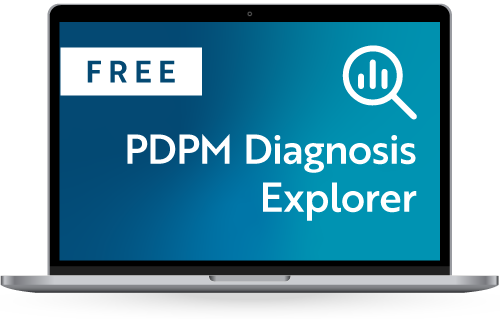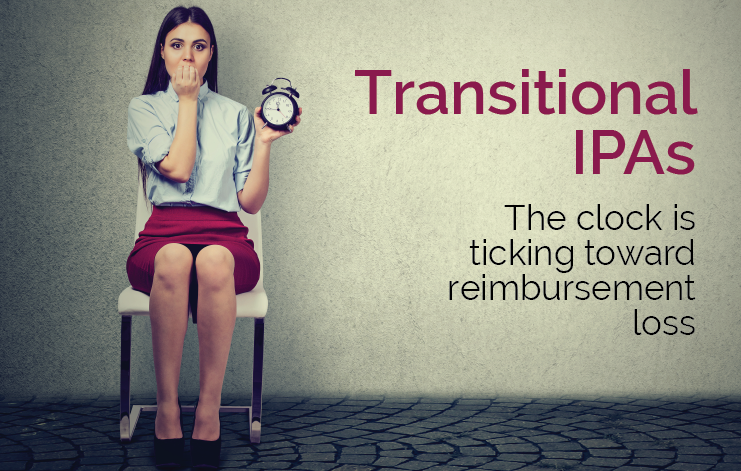Have you completed your Transitional IPAs yet? The clock is ticking and failure to submit a Transitional IPA can negatively impact your overall reimbursement. Here’s a breakdown of Transitional IPA requirements and their connection to PDPM reimbursement.
At SimpleLTC, we’ve looked at the numbers. Among our client base of over 4,000 facilities, only about 300 IPAs have been created since Oct. 7. That number is shockingly low.
Corey Pauley, SimpleLTC’s Director of Engineering & Product, sheds light on why we’re seeing fewer IPAs submitted than expected.
“CMS is still busy patching PDPM bugs and we’ve heard that EHRs are advising providers not to submit IPAs until those changes are rolled into the EHR software,” Pauley said. “This probably explains why we’ve seen so few IPAs at SimpleLTC. However, we’re concerned that providers are overlooking a vital step in PDPM, so we want to alert everyone to the importance of Transitional IPAs.”
While EHRs are busy fixing software bugs, it’s critical for providers to proactively prepare by understanding Transitional IPAs and knowing when to complete them.
With the help of Susan Krall, PT, RAC-CT, Chief Strategy Officer of Quality Rehab Management, we’ve put together this FAQ, along with additional tips/reminders for IPAs. Scroll down to read the answers.
Transitional IPAs 101: What you must know now
When is the deadline for completing a Transitional IPA?
The last possible ARD (A2300) date was Oct. 7. The Transitional IPA must be completed (Item Z0500B) within 14 days after the ARD and must be submitted electronically and accepted into the QIES system within 14 days after completion (item Z0500B). The IPA authorizes payment for the remainder of the PPS stay, beginning on Oct. 1 for this Transitional IPA.
What are the risks of missing the deadline?
Failure to complete and submit a Transitional IPA can result in a loss of reimbursement. If the SNF fails to set the ARD within the defined ARD window for a PPS assessment, and the resident is still on Part A, there are two options:
- Complete a late assessment. The ARD can be no earlier than the day the error was identified.
- Bill the default rate for the number of days that the assessment is out of compliance (number of days between the day following the last day of the available ARD window and the late ARD – including the late ARD).
- Bill the Health Insurance Prospective Payment System (HIPPS) code established by the late assessment for the remaining period that the assessment would have controlled payment.
- For example, a 5-Day assessment with an ARD of Day 11 is out of compliance for 3 days and therefore would be paid at the default rate for Days 1 through 3 and the HIPPS code from the late 5-Day assessment for the remainder of the Part A stay, unless an IPA is completed.
- Variable per diem schedule still begins on Day 1 of the stay and not with the late assessment ARD.
- Complete a missed assessment. If the SNF fails to set the ARD of a PPS assessment prior to the end of the last day of the ARD window, and the resident is no longer a SNF Part A resident.
- In order to bill for Medicare SNF Part A services, the provider must submit a valid PPS assessment that is accepted into the QIES ASAP system. The provider must bill the HIPPS code that is verified by the system.
- If the resident was already discharged from Medicare Part A when this is discovered, a PPS assessment may not be performed.
- However, there are instances when the SNF may bill the default code when a PPS assessment does not exist in the QIES ASAP system. These exceptions are:
-
-
- The stay is less than 8 days within a spell of illness
- The SNF is notified on an untimely basis of or is unaware of a Medicare Secondary Payer denial
- The SNF is notified on an untimely basis of a beneficiary’s enrollment in Medicare Part A,
- The SNF is notified on an untimely basis of the revocation of a payment ban,
- The beneficiary requests a demand bill, or
- The SNF is notified on an untimely basis or is unaware of a beneficiary’s disenrollment from a Medicare Advantage plan
-
Is there any flexibility/variability in the dates?
For the Transitional IPA, only the Variable Adjustment Schedule or (Variable Per Diem VPD) will begin on Oct. 1. NTA will be tripled in payment for Oct. 1 through Oct. 3 and PT/OT reduction of 2% will begin on Oct. 21.
What day of the PDPM variable adjustment schedule will residents start on?
For the Transitional IPA, only the Variable Adjustment Schedule or (Variable Per Diem VPD) will begin on 10/1. NTA will be tripled in payment for 10/1 – 10/3 and PT/OT reduction of 2% will begin on 10/21.
GG interim performance for the IPA includes which days of the stay?
IPA GG assessment window for gathering of the “interim performance” is the ARD and two days prior.
Do new BIMs and PHQ-9 need to be completed?
The BIMs and PHQ-9 information must be captured within the assessment window look back period of the IPA ARD.
Additional reminders/tips
- The IPA may not be combined with any other assessments (PPS or OBRA).
- The ARD for an IPA may not precede that of the 5-Day assessment.
- Diagnoses: The primary reason for the SNF stay diagnosis in I0020B as well as all SLP and NTA co-morbidities pulling from I8000 of the MDS must be checked against the CMS ICD10 Mapping Tool to ensure capture.
-
- Active Diagnoses: “Diagnoses that have a direct relationship to the resident’s current functional, cognitive, or mood or behavior status, medical treatments, nursing monitoring, or risk of death during the 7-day look-back period. Do not include conditions that have been resolved, do not affect the resident’s current status, or do not drive the resident’s plan of care during the 7-day look-back period, as these would be considered inactive diagnoses.” There are two look-back periods for this section:
- Diagnosis identification (Step 1) is a 60-day look-back period.
- Diagnosis status: Active or Inactive (Step 2) is a 7-day look-back period (except for Item I2300 UTI, which does not use the active 7-day look-back period).
- Active Diagnoses: “Diagnoses that have a direct relationship to the resident’s current functional, cognitive, or mood or behavior status, medical treatments, nursing monitoring, or risk of death during the 7-day look-back period. Do not include conditions that have been resolved, do not affect the resident’s current status, or do not drive the resident’s plan of care during the 7-day look-back period, as these would be considered inactive diagnoses.” There are two look-back periods for this section:
-
-
-
- Identify diagnoses: The disease conditions in this section require a physician-documented diagnosis (or by a nurse practitioner, physician assistant, or clinical nurse specialist if allowable under state licensure laws) in the last 60 days.
- Medical record sources for physician diagnoses include progress notes, the most recent history and physical, transfer documents, discharge summaries, diagnosis/ problem list, and other resources as available.
- If a diagnosis/problem list is used, only diagnoses confirmed by the physician should be entered.
-
If you read nothing else, read this…
Failure to submit a Transitional IPA can negatively impact your reimbursement. Whether or not your EHR vendor is ready for you to complete your Transitional IPAs, you can be one step ahead by proactively preparing now.
The Transitional IPA’s last possible ARD (A2300) date was Oct. 7. Given that you have 14 days from the ARD to complete and 14 days from completion to submit, the last date to successfully complete is Mon., Oct. 21 and to submit is Monday, Nov. 4.
If you’re a SimpleLTC customer and you need help with submitting Transitional IPAs, don’t hesitate to reach out to our support team. We know this is a lot of information and we want to make sure you don’t lose out on the reimbursement you deserve.
This blog is sponsored by…
 Quality Rehab Management (QRM) is a Rehabilitation Management Team helping skilled nursing operators navigate PDPM in the realm of speech, occupational and physical therapy.
Quality Rehab Management (QRM) is a Rehabilitation Management Team helping skilled nursing operators navigate PDPM in the realm of speech, occupational and physical therapy. SimpleLTC software improves quality measures, reduces rehospitalizations, optimizes PDPM performance, and maximizes MDS and PBJ accuracy for 4000+ facilities.
SimpleLTC software improves quality measures, reduces rehospitalizations, optimizes PDPM performance, and maximizes MDS and PBJ accuracy for 4000+ facilities. 



